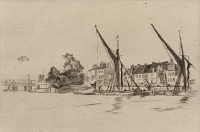Lindsey Houses | ||
| Number: | 161 | |
| Date: | 1876/1877 | |
| Medium: | drypoint | |
| Size: | 153 x 230 mm | |
| Signed: | butterfly at left | |
| Inscribed: | no | |
| Set/Publication: | 'Cancelled Plates', 1879 | |
| No. of States: | 4 | |
| Known impressions: | 25 | |
| Catalogues: | K.166; M.162; W.136 | |
| Impressions taken from this plate (25) | ||
TECHNIQUE
It is pure drypoint, with regular drypoint shading and alterations on the barges, buildings, trees and reflections, and these created a soft effect.
PRINTING
In 1877 Whistler was encouraged by Charles Augustus Howell (1840?-1890), with the help of Rosa Frances Corder (1853-1893), to print from his old etching plates. He told the story years later to the Pennells:
'Howell said: "Why, you have etched many plates, haven't you? You must get them out, you must print them, you must let me see them - there's gold waiting. And you have a press!" And so I had, in a room upstairs, only it was rusty, it hadn't been used for so long. But Howell wouldn't listen to an objection. He said he would fix the press, he would pull it. ... And the next morning, there we all were, Miss Rosa Corder too, and Howell was pulling at the wheel, and there were basins of water, and paper being damped, and prints being dried, and then Howell was grinding more ink, and, with the plates under my fingers, I felt all the old love of it come back.' 11
Whistler kept a cryptic record of printing and sales. For instance, in records of sales to Howell and others in 1877 he listed this drypoint as follows:
Lindsey Houses No. 3 ' ' '
Lindsey Houses No. 4 ' ' ' x
Lindsey Houses 5. ' ' 12
Lindsey Houses No. 4 ' ' ' x
Lindsey Houses 5. ' ' 12
This could mean that there were six or seven impressions available, possibly just printed (for it is known that Whistler printed a substantial number of his copper plates in 1877) and that they were numbered 'No. 3', 'No. 4', etc. , and the asterics indicated how many were left. The 'x' might denote a print selected for exhibition or for a particular dealer or collector, but this is impossible to confirm.
Whistler wrote '1st. State - only proof -' on the first proof (). The seven impressions that have been located were printed in black ink on laid paper. Several are on De Erven De Blauw watermarked paper (, ), or on other watermarked papers (); including off-white paper with the Arms of Amsterdam watermark (), and some on ivory paper from an old book, with sewing holes visible (), including one on a sheet with wormholes ().
It was published in an album of Cancelled Plates ('Cancelled Set') by The Fine Art Society, London, 1879. There appears to have been an edition of at least 20 and possibly 24. Most extant impressions are in this set of cancelled etchings and were printed in black ink on papers that include cream 'modern' (post-1800) Van Gelder laid paper () and ivory laid medium-weight paper with the watermark of a Strasbourg Lily and 'LGZ' (, ).
